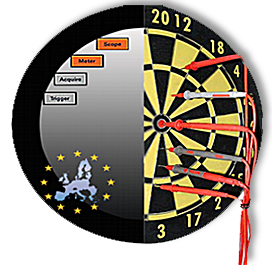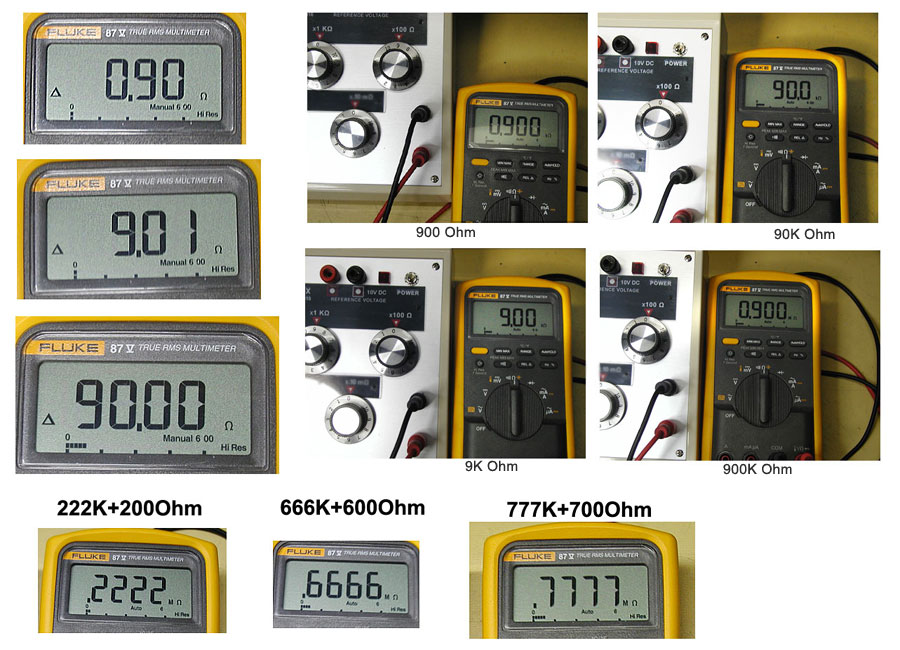
Electrical test and measurement equipment Blog

ITTSB Europe

DIY decade resistors box with build in reference DC source.
Written by Kiriakos Triantafillou © 12 March 2013
Not many years back and actually in 2010 I got interested to discover few basics regarding multimeter testing, and in a way I came close to rules set by metrology which actually is a science.
New words were added in my vocabulary as Ultra low Drift, ppm/C, Precision Reference, reference chip, and a few more.
The added complexity of those technical terms did not stopped from making my own well made decade box.
In the question of what makes one decade resistor box to be named as well made? The answer is the quality of the parts:
1) Branded resistors with the lowest tolerance factor
2) Branded switches with extremely low inner resistance with gold plated or silver plated contacts.
3) Silver plated point to point wiring
4) Lead free Solder with silver
5) Successfully chosen knobs so the numbering to match with the switches position.
6) The correct panel box that it would make the device as highly practical about using it.
The built in reference DC source it is a personal after thought which it did add further value in the all package, and even if this addition it did bump up the total cost of the materials, today I can say (2013) that it was an extremely wise move.
The parts selection was not an easy work to do.
I got the inspiration about selecting DALE resistors by watching a tear down video of the Agilent U1272A.
Back then I was a fresh owner of a Fluke 87V which found to have a limitation at the ohms range in the high resolution mode (20,000 counts), and it was incapable to measure at the lowest range more than 200 Ohm = design limitation at 600 Ohm range.
Regarding the switches I was looking for something very special, and luckily I found it on eBay.
Those switches are silver plated and they were made to serve in the cockpit of air planes.
The eBay seller shared with me the info when I ordered and a second batch that those switches were coming from NASA as unused leftovers of old projects and it was impossible to find more stock from those parts.
Naturally I did not have in mind to build a Space Shuttle but I do love the bragging rights!!
About the knobs for those switches’ I got in to a problem with the first batch which I ordered, the magic keyword for eBay searches about this items is: Guitar AMP DIY metal CAP BELL.
While I selected the proper item with 10 marked positions the ones that I received was having 10 with wrong stepping.
The Chinese seller accepted the mistake and he did send over the right ones at no extra cost.
As tip about the proper knob stepping for a switch with nine positions, I will say that by looking it and by having the zero number at the top, the number six should be shown at the bottom of the knob.
The panel box came from England but the actual product is made in Spain, I have thrown away the simple sticker on the nylon cover which was the only proof of origin.
Either way the box found to be more than perfect for the task and all that I added to it was four rubber pads at the bottom of it.
Regarding planning and drilling holes this is something that I did not do it with hasty.
By the use of CorelDraw X3 software I started to build my decade box in the screen of my computer.
With lots of patience and accurately measured parts dimensions I did the perfect planning by moving around the parts so to find the best position for its and every one.
The gain of this extra effort was double, especially when I came to design the labels for my knobs and banana jacks.
My faithful HP 970CXi did a perfect work on photo paper, but what probably is hard to detect in my pictures is that above the printed labels there is clear sheet of hard plastic as protection, which is bolted on the aluminium faceplate with tiny screws which are coming from the body of a dead digital photo camera.
Regarding drilling even if I own more than six power drills of all sorts, plus an significant amount of drill bits most of them was have some wear, and they was not good enough so to touch soft aluminium, especially when the accurate spacing and its hole dimensions were nonnegotiable regarding mistakes.
In my search for drill bits I discovered that the truly well made ones, they have an significant higher price point than the ordinary ones.
My second discovery was about the fact that the good drill bits obey in the law or limits of max rotations per second so to perform the job with out getting damaged.
At my forum there is the presentation of my Digital Tachometer DT-2234C+, this tool it did proven it value about confirming the rotations speed of my power drill.
The most cost effective solution of high quality drill bits was that HAWERA HSS-G which have specifications for comfort / Fast / Precise Drilling.
The secret behind the real HSS-G drills is that at their manufacturing stage they are double processed by a lathe at their entry point (head), and this helps further their penetration speed and naturally their accuracy.
My father teaches me how to use a lathe when I was young, he was using one small Italian made one for simple tasks as car electrician that he was.
By getting those expensive drills the firs thought that came to me as advice from the past, was to not use them with out special lubrication.
I do not thing that there are other secrets behind this decade box which are worth mentioning, I have add for you a significant amount of pictures as help so to replicate it if you are an ambitious fellow regarding quality.
There is out there commercial solutions of high quality decade boxes which some they come even with calibration certificates, but they cost from few hundreds to few thousands of dollars, one industrial electrician it can not jump that high.
One last alternative it is those cheap made decade resistor boxes on eBay, but they are using low cost switches and SMD resistors, which makes them prone to damage.
Some people will say that is better than nothing, but in this case why to not build your own, so to gain the chance to have something to remember as personal project by getting older.
Personally I have do as part of my job countless repairs and modifications at my customers, but when I like to remember of what I am capable to do I am always looking at my own two hand made power supplies which are true gems from every aspect.
I hope all this rumpling to boost your motivation so to start your own project.
Parts list:
Resistors made by Dale ( U.S.A.) 0.1% of accuracy.
The DC reference chip are the
LT1021 by Linear Technology Corporation (www.linear.com)
Ultra low Drift: 5ppm/°C
Max Slope
Very Low Noise: <1ppm P-P (0.1Hz to 10Hz)
Regarding power source I have use
four coin type batteries 3V x 4 = 12V
The total cost of just the spare parts got up to 125 EUR.
At 8/2013 my box would become three years old, even today I am full of pride about it, due it excellent stability, also due the fact that it is my own work, and also because it is a personal reminder of the year that I made my first step to explore few basics regarding metrology.
Enjoy the pictures, and good luck if you decide to follow my path about making your own.
1) Switches and testing
2) Drilling
3) Labels
5) Assembly of basic parts
6) DC source testing
7) Resistor decade testing, total inner resistance of first stages and the sum of all stages.
8) Final verification of all stages.

9) Parts list and specifications
10) Final product and amazing look
This project is dedicated in the memory of my father Andrew Triantafillou who was other than a good father to me and a great teacher who unfortunately passed away at 1985 when I was just sixteen years old.
Even so he did passed to me principals like patience and the use of the ultimate craftsmanship in everything I do, no matter if I do it for me or for a customer.

Copyright Notice:
The content of this web site is copyright protected. You may download, display, print and reproduce this material in unaltered form only (retaining this notice) for your personal, non-commercial use or use within your organization. Apart from any use as permitted under Hellenic Copyright law, all other rights are reserved. Requests and inquiries concerning reproduction and rights should be addressed to: Kiriakos Triantafillou, 55 Gatsou, TK38333, Volos, Greece, E-mail: info@ittsb(dot)eu
You are not permitted to commercialize the information or material without seeking prior written approval from Kiriakos A. Triantafillou. You are not permitted to use the ITTSB.EU web site to sell a product or to increase traffic to your web site.
Kiriakos Triantafillou © 2012 - 2026
Name space registered to EURid May 8, 2012